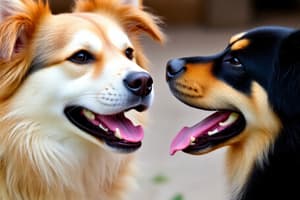Podcast
Questions and Answers
What is the primary purpose of a dog's body language?
What is the primary purpose of a dog's body language?
- To entertain humans
- To signal for food
- To display dominance
- To communicate purposefully (correct)
Which of the following is not a factor necessary for communication?
Which of the following is not a factor necessary for communication?
- Receiver
- Environment (correct)
- Signal
- Sender
How do dogs typically adapt to human communication?
How do dogs typically adapt to human communication?
- They ignore human signals entirely
- They write notes to humans
- They attempt to communicate like they would with other dogs (correct)
- They learn to bark in human languages
At what age do puppies typically start barking?
At what age do puppies typically start barking?
What can differences in barking pitch indicate?
What can differences in barking pitch indicate?
Which behavior is NOT a form of deliberate communication in dogs?
Which behavior is NOT a form of deliberate communication in dogs?
What has traditionally characterized dog training methods?
What has traditionally characterized dog training methods?
Which statement about canine vocal communication is true?
Which statement about canine vocal communication is true?
What does an exaggerated yawn in dogs signify?
What does an exaggerated yawn in dogs signify?
Which calming signal might a dog use to help calm a frustrated owner?
Which calming signal might a dog use to help calm a frustrated owner?
What is the purpose of body shaking in dogs?
What is the purpose of body shaking in dogs?
What behavior involves a dog moving between two other dogs during play?
What behavior involves a dog moving between two other dogs during play?
What is typically a self-directed displacement behavior in dogs?
What is typically a self-directed displacement behavior in dogs?
Which behavior is a common example of re-directed displacement?
Which behavior is a common example of re-directed displacement?
Which statement is true regarding calming signals in dogs?
Which statement is true regarding calming signals in dogs?
When experiencing emotional conflict, a dog may engage in which behavior?
When experiencing emotional conflict, a dog may engage in which behavior?
What is the primary reason dogs growl?
What is the primary reason dogs growl?
When do puppies typically begin to growl?
When do puppies typically begin to growl?
What does a dog do when it snarls?
What does a dog do when it snarls?
Why do dogs sometimes howl?
Why do dogs sometimes howl?
What is a calming signal in dogs?
What is a calming signal in dogs?
What often accompanies a whimper or yelp in dogs?
What often accompanies a whimper or yelp in dogs?
What is commonly mistaken for growling?
What is commonly mistaken for growling?
What might cause a dog to growl when being petted?
What might cause a dog to growl when being petted?
What is the purpose of blinking for dogs?
What is the purpose of blinking for dogs?
When dogs approach each other, what is the proper manner?
When dogs approach each other, what is the proper manner?
What behavior might indicate a dog is feeling nervous?
What behavior might indicate a dog is feeling nervous?
What does a play bow signal from a dog?
What does a play bow signal from a dog?
Why might a dog lick its mouth or nose?
Why might a dog lick its mouth or nose?
What behavior is commonly seen when dogs are greeting each other?
What behavior is commonly seen when dogs are greeting each other?
What is the primary reason dogs may walk slowly?
What is the primary reason dogs may walk slowly?
What does a dog do when it looks away from a situation?
What does a dog do when it looks away from a situation?
What is the main purpose of distance decreasing signals?
What is the main purpose of distance decreasing signals?
Which of the following is NOT a type of distance increasing signal?
Which of the following is NOT a type of distance increasing signal?
What does 'whale eye' refer to in canine communication?
What does 'whale eye' refer to in canine communication?
What is a hard stare and what does it indicate?
What is a hard stare and what does it indicate?
What action occurs during a freeze in canine behavior?
What action occurs during a freeze in canine behavior?
What does a muzzle punch typically indicate?
What does a muzzle punch typically indicate?
What should you do if you observe multiple warning signals from a dog?
What should you do if you observe multiple warning signals from a dog?
Which of the following is a characteristic of the head flick signal?
Which of the following is a characteristic of the head flick signal?
What does a growl typically indicate in canine communication?
What does a growl typically indicate in canine communication?
Which of the following best defines aggression in dogs?
Which of the following best defines aggression in dogs?
What is a common reason for producing distance-increasing actions like barking or growling?
What is a common reason for producing distance-increasing actions like barking or growling?
Which breed is mentioned as likely having a predisposition to displaying aggression?
Which breed is mentioned as likely having a predisposition to displaying aggression?
What might affect a dog's likelihood of developing fear-based aggression?
What might affect a dog's likelihood of developing fear-based aggression?
Can dogs with dog-aggressive behavior also show aggression towards humans?
Can dogs with dog-aggressive behavior also show aggression towards humans?
How do puppies learn to communicate effectively?
How do puppies learn to communicate effectively?
Why is understanding a dog's body language important?
Why is understanding a dog's body language important?
What body posture is characteristic of a fearful dog?
What body posture is characteristic of a fearful dog?
Which vocalization might indicate a fearful dog?
Which vocalization might indicate a fearful dog?
How should one properly interact with a fearful dog?
How should one properly interact with a fearful dog?
What is a submissive grin in dogs indicative of?
What is a submissive grin in dogs indicative of?
A dog showing a fearful body posture will typically have which of the following?
A dog showing a fearful body posture will typically have which of the following?
What body language suggests a dog is displaying an offensive threat posture?
What body language suggests a dog is displaying an offensive threat posture?
What should you do if you encounter a dog displaying an offensive threat posture?
What should you do if you encounter a dog displaying an offensive threat posture?
What behavior might lead you to identify a dog as being in a threatening state?
What behavior might lead you to identify a dog as being in a threatening state?
How do hackles relate to a dog's emotional state?
How do hackles relate to a dog's emotional state?
What is a proper response to witnessing a dog with raised hackles?
What is a proper response to witnessing a dog with raised hackles?
Which characteristics indicate a relaxed and neutral dog posture?
Which characteristics indicate a relaxed and neutral dog posture?
What is an appropriate way to approach a relaxed dog?
What is an appropriate way to approach a relaxed dog?
What might indicate that a dog is not relaxed?
What might indicate that a dog is not relaxed?
Why is it important to be aware of your own body language when interacting with dogs?
Why is it important to be aware of your own body language when interacting with dogs?
What is typically not a feature of a relaxed dog?
What is typically not a feature of a relaxed dog?
Which behavior indicates a dog is in an alert or aroused body posture?
Which behavior indicates a dog is in an alert or aroused body posture?
What is a recommended way to interact with an alert dog?
What is a recommended way to interact with an alert dog?
What vocalization might indicate a dog is alert or aroused?
What vocalization might indicate a dog is alert or aroused?
Which of the following is NOT a characteristic of an alert dog’s body posture?
Which of the following is NOT a characteristic of an alert dog’s body posture?
Why should you avoid kneeling or going down to a dog's level when interacting with an alert or aroused dog?
Why should you avoid kneeling or going down to a dog's level when interacting with an alert or aroused dog?
Flashcards are hidden until you start studying
Study Notes
Communication
- Dogs communicate deliberately using body language, including posture, gestures, and facial expressions.
- Effective communication requires a sender, a receiver, and a signal, interpreted via sight, hearing, touch, taste, and smell.
- Misunderstandings between dogs and humans stem from different communication methods; dogs adapt to human language yet cannot acquire it.
- Signs of fear in dogs are often involuntary and indicate emotional state rather than deliberate communication.
Canine Verbal Communication
- Vocalizations are diverse and express individual and physiological states; dogs are more vocal than wolves.
- Barking: Begins at 2-4 weeks; signals greetings, distress, warnings, and play; higher pitches indicate play while lower pitches indicate threats.
- Growling: Used in play, as a warning, or a defense signal; growls can vary in context depending on the situation.
- Howl: Used to connect with others; can signify joy or the need for social interaction.
- Snarl: Indicates aggressive intent, characterized by showing teeth; a sign of either offensive or defensive aggression.
- Whimper/Yelp: Indicates pain or distress.
- Whine: High-pitched sound often associated with distress, fear, or attention-seeking behavior.
Canine Body Language
- Dogs use various body signals to communicate and predict behavior.
- Observing body language is crucial in applying appropriate training and ensuring safety.
- Calming signals help dogs manage stress and establish communication; they include blinking, curving, licking, looking away, and more.
Positive Approach Canine Education
- Calming Signals: Help reduce tension; examples include yawning, paw lifts, shaking, and scratching.
- Displacement Behaviors: Normal actions done at inappropriate times to alleviate emotional conflict, can be self-directed or redirected.
- Distance Decreasing Signals: Encourage approach and reduce perceived threats; involve passive and active submission.
- Distance Increasing Signals: Minimize interactions; serve as warnings and aggression displays.
Warning Signals
- Whale Eye: Seeing the whites of a dog's eyes indicates discomfort or readiness to act defensively.
- Freeze: Sudden cessation of movement that conveys hesitation or fear.
- Muzzle Punch: Thrusting the muzzle as a warning or rude greeting.
- Hard Stare: Intense eye contact signaling potential aggression.
- Head Flick: Quick movement away from an unsettling stimulus.
Aggression and Body Posture
- Relaxed Body Posture: Signifies comfort and openness, characterized by loose lips, relaxed tail, and soft eyes.
- Alert Body Posture: Ears perked, wide-open eyes, and a tense stance indicate heightened awareness.
- Fearful Body Posture: Flattened ears, dilated pupils, and cowering suggest fear or discomfort.
- Submissive Grin: Exposing teeth in a non-threatening manner, indicating appeasement.
- Offensive Threat Posture: Alert ears, narrowed eyes, and bared teeth suggest a readiness to confront.
Hackles/Piloerection
- Hackles rise in response to arousal or perceived threat, an indicator of a dog's emotional state.
Studying That Suits You
Use AI to generate personalized quizzes and flashcards to suit your learning preferences.




